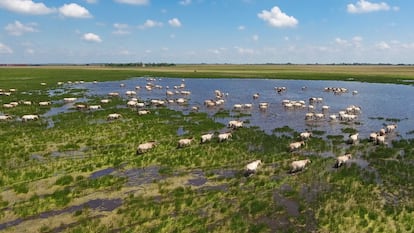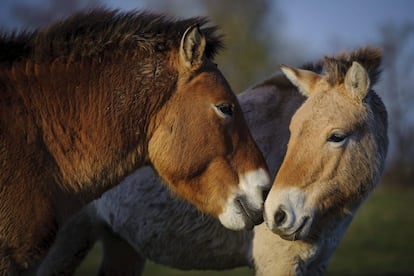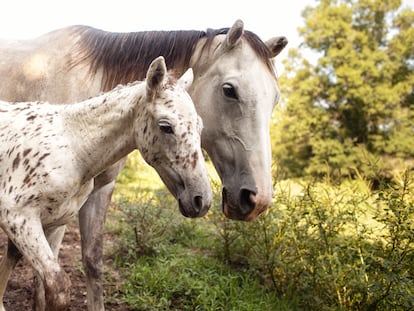Herd movements show the complex social structure of the last wild horses
Przewalski’s stallions group their harems to protect them from rivals and predators, while females in the same group move together

Studying the movements of Przewalski’s horses makes it possible to anticipate the harem to which a female will go and the harem she comes from. Far from moving chaotically, a herd of the last subspecies of wild equids follows a rigid, hierarchical social structure. The most senior stallions with the largest harems are grouped together in an exercise of collective defense that is seen in very few species other than hominids.
There are only about 3,000 individual Przewalski’s horses. Most of them live in Mongolia, their native land. But there are also scattered herds in Eastern Europe, such as the ones in Chernobyl. One of the largest herds is in Hortobágy National Park in Hungary. About twenty adult horses arrived there at the end of the last century in an attempt to increase the horses’ chances of survival. It worked. Barely 25 years later, there are already 278 horses in the park, grouped in 28 harems. Based on what was known about these animals, in the Mongolian steppes they form a stallion-led harem of a dozen or fewer females and their offspring.
The male foals are expelled when they approach reproductive age, and they join other youngsters in the hopes of being able to form their own harem or take one from a stallion. The females usually leave the family group. But in Hortobágy something happens that doesn’t occur in Mongolia: the harems move together, forming a large herd. Now, a detailed study of this herd reveals that the animals do not move chaotically or randomly, but rather follow a complex social network structure.
A group of Hungarian researchers have taken advantage of the fact that they know almost everything about the Hortobágy herd, the age of each animal, its gender, its kinship with others, its genetics... This allowed them to study the social structure of these horses. To all this previously known data, scientists added the information they believed could be determined by observing the herd’s movement from the air with drones. The result of this work, published in the scientific journal Nature Communications, confirms several of the things that were already known, but it has also added new information.
“Their social structure, i.e., that horses live in stable harems and bachelor groups, was known as a result of long-term monitoring by park staff,” says Katalin Ozogány, an animal behavior researcher at the University of Debrecen, Hungary, and the lead author of the paper. “We were confident that the movement patterns might be related to that social structure, because harem members generally stay close to each other, while keeping a greater distance from others. And this more or less holds true during movements as well. We also expected that past affiliations in the same harem might have an effect, as friendships can develop over time.” But, she adds, the researchers did not expect that “future social relationships might be related to the movement.” Indeed, the drone recordings made it possible to determine where a female might end up and the harem from which she came.

The study confirms the central position of stallions, especially older ones with larger harems. It also shows that the harems of his brothers tend to stay around his own group. Their half-siblings are second in the hierarchy, followed by males unrelated to those occupying the center and finally the groups of non-breeding males. “We assume that the harem’s stallions form a kind of alliance with each other to protect their harems more effectively against single males, and the margins in the detected network represent these alliances,” Ozogány says. “Based on this, the advantage for the stallions is that they don’t have to expend as much energy in battles with bachelors, so they can probably keep their harems longer. In addition, it is also beneficial for females to be surrounded by allied harems, as this can reduce the possibility of harassment by bachelors and foal killing,” she adds.
This hierarchical social organization around dominant stallions runs parallel to another, more fluid, female social structure. As Hungarian Academy of Sciences researcher and senior author of the paper Máté Nagy summarizes: “At first glance, one might think that harem stallions simply maintain several females with occasional fights with other stallions that can end up with a new, previously single male gaining control of the harem. But, in reality, the dynamics are much more complex. Harems can split or merge, and females can decide to change harems.” The researchers have found that kinship does not have a network effect, but friendship does: related females do not tend to group together in the same harem. That favors genetic diversity. But mares that shared a harem in the past tend to move together. They also tend to move to a different harem together as well. “The fact that future female interactions can be predicted by the joint movements of individuals has exceeded our expectations,” Nagy says.
However, the researchers can’t explain the difference between Przewalski’s horses in Mongolia, which do not form large herds, and the ones in Hortobágy. Ozogány offers some possible reasons: “Presumably, several environmental and social factors may influence the formation of large herds from harems. For example, food abundance, water availability, the presence of predators and bachelor groups may influence the formation of herds. To better understand their formation under more natural conditions, our study should be repeated in Mongolia.”
Sign up for our weekly newsletter to get more English-language news coverage from EL PAÍS USA Edition
Tu suscripción se está usando en otro dispositivo
¿Quieres añadir otro usuario a tu suscripción?
Si continúas leyendo en este dispositivo, no se podrá leer en el otro.
FlechaTu suscripción se está usando en otro dispositivo y solo puedes acceder a EL PAÍS desde un dispositivo a la vez.
Si quieres compartir tu cuenta, cambia tu suscripción a la modalidad Premium, así podrás añadir otro usuario. Cada uno accederá con su propia cuenta de email, lo que os permitirá personalizar vuestra experiencia en EL PAÍS.
¿Tienes una suscripción de empresa? Accede aquí para contratar más cuentas.
En el caso de no saber quién está usando tu cuenta, te recomendamos cambiar tu contraseña aquí.
Si decides continuar compartiendo tu cuenta, este mensaje se mostrará en tu dispositivo y en el de la otra persona que está usando tu cuenta de forma indefinida, afectando a tu experiencia de lectura. Puedes consultar aquí los términos y condiciones de la suscripción digital.
More information
Archived In
Últimas noticias
The complicated life of Francesca Albanese: A rising figure in Italy but barred from every bank by Trump’s sanctions
Reinhard Genzel, Nobel laureate in physics: ‘One-minute videos will never give you the truth’
Pinochet’s victims grapple with José Antonio Kast’s rise in Chile
How Japan is trying to avert ‘digital defeat’
Most viewed
- Pablo Escobar’s hippos: A serious environmental problem, 40 years on
- Reinhard Genzel, Nobel laureate in physics: ‘One-minute videos will never give you the truth’
- Why we lost the habit of sleeping in two segments and how that changed our sense of time
- Charles Dubouloz, mountaineering star, retires at 36 with a farewell tour inspired by Walter Bonatti
- The Florida Keys tourist paradise is besieged by immigration agents: ‘We’ve never seen anything like this’










































